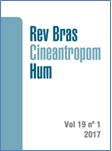A razão de troca respiratória é uma alternativa para estimar o limiar anaeróbio em corredores treinados?
DOI:
https://doi.org/10.1590/1980-0037.2017v19n1p108Resumo
Diversos estudos demonstram que a razão de troca respiratória (RER) tem sido utilizada como uma alternativa para estimar a capacidade aeróbia em único teste incremental. No entanto, poucos estudos foram realizados com corredores treinados. Sendo assim, o objetivo do estudo foi avaliar a utilização do RER como uma alternativa para estimar o limiar anaeróbio (AT) em corredores de longa distância. Dezenove corredores de longa distância do sexo masculino participaram do estudo. Foi realizado um teste incremental com velocidade inicial de 10 km·h-1 com incrementos de 1 km·h-1 a cada minuto até a exaustão voluntária. As variáveis mensuradas foram consumo de oxigênio (VO2), limiares ventilatórios (VT1 e VT2), intensidade correspondente ao RER no valor igual a 1,0 (iRER1.0), pico de velocidade (PV), frequência cardíaca (HR) e percepção subjetiva de esforço (RPE). Foi realizada a análise de variância de medidas repetidas do tipo one-way, seguido do teste post hoc de Bonferroni. A relação entre as variáveis foi verificada pela correlação de Pearson e a concordância por meio da medida de dispersão dos erros. Não houve diferença significativa entre as variáveis iRER1.0 e VT2. Foram encontradas correlações significativas entre as variáveis iRER1.0 e VT2 para os valores absolutos e relativos de VO2, velocidade e HR (r=0,95; r=0,60; r=0,72; r=0,81, respectivamente). Um pequeno erro médio (-0,2 km·h-1) foi observado entre iRER1.0 e VT2, bem como uma tendência de superestimação em altas velocidade. Em conclusão, iRER1.0 pode ser utilizado como um método alternativo para detectar o AT em corredores de longa distância, entretanto, seu uso é limitado em corredores com alta capacidade aeróbia.
Downloads
Publicado
Edição
Seção
Licença

Direitos Autorais para artigos publicados nesta revista são do autor, com direitos de primeira publicação para a revista. Em virtude da aparecerem nesta revista de acesso público, os artigos são de uso gratuito, com atribuições próprias, em aplicações educacionais e não-comerciais, desde que seja dada a atribuição. Esta obra foi licenciada com uma Licença Creative Commons Atribuição 4.0 Internacional - CC BY


